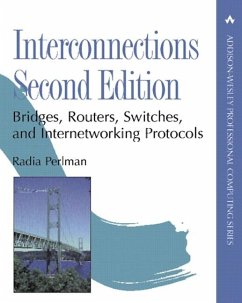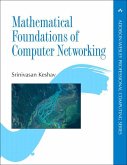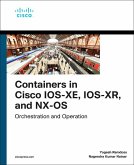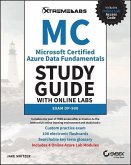- Gebundenes Buch
- Merkliste
- Auf die Merkliste
- Bewerten Bewerten
- Teilen
- Produkt teilen
- Produkterinnerung
- Produkterinnerung
Backcover ------------------------------------------------------------------------ Biography ------------------------------------------------------------------------ TOC ------------------------------------------------------------------------
Andere Kunden interessierten sich auch für
![Mathematical Foundations of Computer Networking Mathematical Foundations of Computer Networking]() Srinivasan KeshavMathematical Foundations of Computer Networking83,99 €
Srinivasan KeshavMathematical Foundations of Computer Networking83,99 €![Transforming Campus Networks to Intent-Based Networking Transforming Campus Networks to Intent-Based Networking]() Pieter-Jan NefkensTransforming Campus Networks to Intent-Based Networking68,99 €
Pieter-Jan NefkensTransforming Campus Networks to Intent-Based Networking68,99 €![Containers in Cisco Ios-Xe, Ios-Xr, and Nx-OS Containers in Cisco Ios-Xe, Ios-Xr, and Nx-OS]() Yogesh RamdossContainers in Cisco Ios-Xe, Ios-Xr, and Nx-OS40,99 €
Yogesh RamdossContainers in Cisco Ios-Xe, Ios-Xr, and Nx-OS40,99 €![Controlling Privacy and the Use of Data Assets - Volume 1 Controlling Privacy and the Use of Data Assets - Volume 1]() Ulf MattssonControlling Privacy and the Use of Data Assets - Volume 138,99 €
Ulf MattssonControlling Privacy and the Use of Data Assets - Volume 138,99 €![MC Microsoft Certified Azure Data Fundamentals Study Guide with Online Labs: Exam Dp-900 MC Microsoft Certified Azure Data Fundamentals Study Guide with Online Labs: Exam Dp-900]() Jake SwitzerMC Microsoft Certified Azure Data Fundamentals Study Guide with Online Labs: Exam Dp-900113,99 €
Jake SwitzerMC Microsoft Certified Azure Data Fundamentals Study Guide with Online Labs: Exam Dp-900113,99 €![Implementation Techniques Implementation Techniques]() Cornelius T. LeondesImplementation Techniques71,99 €
Cornelius T. LeondesImplementation Techniques71,99 €![Cybersecurity Public Policy Cybersecurity Public Policy]() Bradley FowlerCybersecurity Public Policy112,99 €
Bradley FowlerCybersecurity Public Policy112,99 €-
-
-
Backcover ------------------------------------------------------------------------ Biography ------------------------------------------------------------------------ TOC ------------------------------------------------------------------------
Hinweis: Dieser Artikel kann nur an eine deutsche Lieferadresse ausgeliefert werden.
Hinweis: Dieser Artikel kann nur an eine deutsche Lieferadresse ausgeliefert werden.
Produktdetails
- Produktdetails
- Verlag: Pearson Education
- 2nd edition
- Seitenzahl: 560
- Erscheinungstermin: 14. September 1999
- Englisch
- Abmessung: 244mm x 198mm x 32mm
- Gewicht: 1145g
- ISBN-13: 9780201634488
- ISBN-10: 0201634481
- Artikelnr.: 22260486
- Herstellerkennzeichnung
- Libri GmbH
- Europaallee 1
- 36244 Bad Hersfeld
- gpsr@libri.de
- Verlag: Pearson Education
- 2nd edition
- Seitenzahl: 560
- Erscheinungstermin: 14. September 1999
- Englisch
- Abmessung: 244mm x 198mm x 32mm
- Gewicht: 1145g
- ISBN-13: 9780201634488
- ISBN-10: 0201634481
- Artikelnr.: 22260486
- Herstellerkennzeichnung
- Libri GmbH
- Europaallee 1
- 36244 Bad Hersfeld
- gpsr@libri.de
Radia Perlman's work has had a profound impact on the field of networking. She was recently featured in the 25th anniversary edition of Data Communications magazine as one of the 25 people whose work has most influenced the industry. She is the creator of the spanning tree algorithm upon which bridges (switches) are based, and the algorithms that allow robust and efficient link state routing, upon which all modern link state routing protocols (such as IS-IS, OSPF, and PNNI) are based. Radia designed IS-IS, Simple Multicast, and sabotage-proof routing. She is also co-author of Network Security: Private Communication in a Public World. Both of her books were listed in the top 10 most useful networking reference books in the March, 1988 issue of Network Magazine. She is currently a Distinguished Engineer at Sun Microsystems, Inc. She holds about 50 patents and a Ph.D. from M.I.T. 0201634481AB04062001
Preface.
Roadmap to the Book.
Acknowledgments.
1. Essential Networking Concepts.
Layers.
Service Models.
Important Properties of a Network.
Reliable Data Transfer Protocols.
2. Data Link Layer Issues.
Generic LANs.
IEEE 802 LANs.
Names, Addresses, Routes.
LAN Addresses.
Multicast versus Unicast Addresses.
The Broadcast Address.
Multiplexing Field.
Bit Order.
Logical Link Control.
Issues in 802.3.
Issues in 802.5.
Packet Bursts.
Reasons for Bridges.
Point-to-Point Links.
3. Transparent Bridges.
The No-Frills Bridge.
The Learning Bridge.
Spanning Tree Algorithm.
Spanning Tree Algorithm Refinements.
Bridge Message Formats.
Other Bridge Issues.
Remote Bridges.
4. Source Routing Bridges.
Pure Source Routing.
SR-TB Bridges.
SRT Bridges.
End-system Algorithms.
Source Routing versus Transparent Bridging.
Ideas for Improving Source Route Bridging.
5. Hubs, Switches, Virtual LANs, and Fast Ethernet.
Hubs.
Faster LANs.
Virtual LANs (VLANs).
6. Network Interface: Service Models.
What Is the Network Layer?
Network Service Types.
7. Connection-oriented Nets: X.25 and ATM.
Generic Connection-oriented Network.
X.25: Reliable Connection-oriented Service.
Implementing X.25 Inside the Net.
Asynchronous Transfer Mode.
8. Generic Connectionless Service.
Data Transfer.
Addresses.
Hop Count.
Service Class Information.
Network Feedback.
Fragmentation and Reassembly.
Maximum Packet Size Discovery.
9. Network Layer Addresses.
Hierarchical Addresses with Fixed Boundaries.
Hierarchical Addresses with Flexible Boundaries.
Owning versus Renting Addresses.
Types of Addresses.
IP.
IPX.
IPX+.
IPv6.
CLNP Network Layer Addresses.
AppleTalk Network Layer Addresses.
DECnet Phases III and IV.
NAT/NAPT.
10. Connectionless Data Packet Formats.
Pieces of a Connectionless Network Layer.
Data Packets.
Summary of Packet Formats for Easy Reference.
Technical Issues and Comparisons in Data Packet Formats.
Source Routing.
The Great IPX Frame Format Mystery.
Error Reports and Other Network Feedback to the Endnode.
11. Neighbor Greeting and Autoconfiguration.
Endnodes Attached via Point-to-Point Links.
Endnodes Attached via LANs.
Endnodes Attached via Nonbroadcast Multiaccess Media.
Finding Things.
12. Routing Algorithm Concepts.
Distance Vector Routing.
Link State Routing.
Comparison of Link State and Distance Vector Routing.
Load Splitting.
Link Costs.
Migrating Routing Algorithms.
LANs.
Types of Service.
Partition Repair: Level 1 Subnetwork Partition.
13. Fast Packet Forwarding.
Using an Additional Header.
Address Prefix Matching.
Longest Prefix Match with Trie.
Binary Search.
14. Specific Routing Protocols.
A Brief History of Intradomain Routing Protocols.
RIP.
RTMP, IPX-RIP, and DECnet.
IS-IS, OSPF, NLSP, and PNNI.
Interdomain Routing Protocols.
15. WAN Multicast.
Introduction.
Multicast in IP.
16. Sabotage-proof Routing.
The Problem.
All You Need to Know about Cryptography.
Overview of the Approach.
Detailed Description of the Approach.
Summary.
For Further Reading.
17. To Route, Bridge, or Switch: Is That the Question?
Switches.
Bridges versus Routers.
Extensions to Bridges.
Extensions to Routers.
18. Protocol Design Folklore.
Simplicity versus Flexibility versus Optimality.
Knowing the Problem You're Trying to Solve.
Overhead and Scaling.
Operation Above Capacity.
Compact IDs versus Object Identifiers.
Optimizing for the Most Common or Important Case.
Forward Compatibility.
Migration: Routing Algorithms and Addressing.
Parameters.
Making Multiprotocol Operation Possible.
Running over Layer 3 versus Layer.
Robustness.
Determinism versus Stability.
Performance for Correctness.
In Closing.
Glossary.
Index. 0201634481T04062001
Roadmap to the Book.
Acknowledgments.
1. Essential Networking Concepts.
Layers.
Service Models.
Important Properties of a Network.
Reliable Data Transfer Protocols.
2. Data Link Layer Issues.
Generic LANs.
IEEE 802 LANs.
Names, Addresses, Routes.
LAN Addresses.
Multicast versus Unicast Addresses.
The Broadcast Address.
Multiplexing Field.
Bit Order.
Logical Link Control.
Issues in 802.3.
Issues in 802.5.
Packet Bursts.
Reasons for Bridges.
Point-to-Point Links.
3. Transparent Bridges.
The No-Frills Bridge.
The Learning Bridge.
Spanning Tree Algorithm.
Spanning Tree Algorithm Refinements.
Bridge Message Formats.
Other Bridge Issues.
Remote Bridges.
4. Source Routing Bridges.
Pure Source Routing.
SR-TB Bridges.
SRT Bridges.
End-system Algorithms.
Source Routing versus Transparent Bridging.
Ideas for Improving Source Route Bridging.
5. Hubs, Switches, Virtual LANs, and Fast Ethernet.
Hubs.
Faster LANs.
Virtual LANs (VLANs).
6. Network Interface: Service Models.
What Is the Network Layer?
Network Service Types.
7. Connection-oriented Nets: X.25 and ATM.
Generic Connection-oriented Network.
X.25: Reliable Connection-oriented Service.
Implementing X.25 Inside the Net.
Asynchronous Transfer Mode.
8. Generic Connectionless Service.
Data Transfer.
Addresses.
Hop Count.
Service Class Information.
Network Feedback.
Fragmentation and Reassembly.
Maximum Packet Size Discovery.
9. Network Layer Addresses.
Hierarchical Addresses with Fixed Boundaries.
Hierarchical Addresses with Flexible Boundaries.
Owning versus Renting Addresses.
Types of Addresses.
IP.
IPX.
IPX+.
IPv6.
CLNP Network Layer Addresses.
AppleTalk Network Layer Addresses.
DECnet Phases III and IV.
NAT/NAPT.
10. Connectionless Data Packet Formats.
Pieces of a Connectionless Network Layer.
Data Packets.
Summary of Packet Formats for Easy Reference.
Technical Issues and Comparisons in Data Packet Formats.
Source Routing.
The Great IPX Frame Format Mystery.
Error Reports and Other Network Feedback to the Endnode.
11. Neighbor Greeting and Autoconfiguration.
Endnodes Attached via Point-to-Point Links.
Endnodes Attached via LANs.
Endnodes Attached via Nonbroadcast Multiaccess Media.
Finding Things.
12. Routing Algorithm Concepts.
Distance Vector Routing.
Link State Routing.
Comparison of Link State and Distance Vector Routing.
Load Splitting.
Link Costs.
Migrating Routing Algorithms.
LANs.
Types of Service.
Partition Repair: Level 1 Subnetwork Partition.
13. Fast Packet Forwarding.
Using an Additional Header.
Address Prefix Matching.
Longest Prefix Match with Trie.
Binary Search.
14. Specific Routing Protocols.
A Brief History of Intradomain Routing Protocols.
RIP.
RTMP, IPX-RIP, and DECnet.
IS-IS, OSPF, NLSP, and PNNI.
Interdomain Routing Protocols.
15. WAN Multicast.
Introduction.
Multicast in IP.
16. Sabotage-proof Routing.
The Problem.
All You Need to Know about Cryptography.
Overview of the Approach.
Detailed Description of the Approach.
Summary.
For Further Reading.
17. To Route, Bridge, or Switch: Is That the Question?
Switches.
Bridges versus Routers.
Extensions to Bridges.
Extensions to Routers.
18. Protocol Design Folklore.
Simplicity versus Flexibility versus Optimality.
Knowing the Problem You're Trying to Solve.
Overhead and Scaling.
Operation Above Capacity.
Compact IDs versus Object Identifiers.
Optimizing for the Most Common or Important Case.
Forward Compatibility.
Migration: Routing Algorithms and Addressing.
Parameters.
Making Multiprotocol Operation Possible.
Running over Layer 3 versus Layer.
Robustness.
Determinism versus Stability.
Performance for Correctness.
In Closing.
Glossary.
Index. 0201634481T04062001
Preface.
Roadmap to the Book.
Acknowledgments.
1. Essential Networking Concepts.
Layers.
Service Models.
Important Properties of a Network.
Reliable Data Transfer Protocols.
2. Data Link Layer Issues.
Generic LANs.
IEEE 802 LANs.
Names, Addresses, Routes.
LAN Addresses.
Multicast versus Unicast Addresses.
The Broadcast Address.
Multiplexing Field.
Bit Order.
Logical Link Control.
Issues in 802.3.
Issues in 802.5.
Packet Bursts.
Reasons for Bridges.
Point-to-Point Links.
3. Transparent Bridges.
The No-Frills Bridge.
The Learning Bridge.
Spanning Tree Algorithm.
Spanning Tree Algorithm Refinements.
Bridge Message Formats.
Other Bridge Issues.
Remote Bridges.
4. Source Routing Bridges.
Pure Source Routing.
SR-TB Bridges.
SRT Bridges.
End-system Algorithms.
Source Routing versus Transparent Bridging.
Ideas for Improving Source Route Bridging.
5. Hubs, Switches, Virtual LANs, and Fast Ethernet.
Hubs.
Faster LANs.
Virtual LANs (VLANs).
6. Network Interface: Service Models.
What Is the Network Layer?
Network Service Types.
7. Connection-oriented Nets: X.25 and ATM.
Generic Connection-oriented Network.
X.25: Reliable Connection-oriented Service.
Implementing X.25 Inside the Net.
Asynchronous Transfer Mode.
8. Generic Connectionless Service.
Data Transfer.
Addresses.
Hop Count.
Service Class Information.
Network Feedback.
Fragmentation and Reassembly.
Maximum Packet Size Discovery.
9. Network Layer Addresses.
Hierarchical Addresses with Fixed Boundaries.
Hierarchical Addresses with Flexible Boundaries.
Owning versus Renting Addresses.
Types of Addresses.
IP.
IPX.
IPX+.
IPv6.
CLNP Network Layer Addresses.
AppleTalk Network Layer Addresses.
DECnet Phases III and IV.
NAT/NAPT.
10. Connectionless Data Packet Formats.
Pieces of a Connectionless Network Layer.
Data Packets.
Summary of Packet Formats for Easy Reference.
Technical Issues and Comparisons in Data Packet Formats.
Source Routing.
The Great IPX Frame Format Mystery.
Error Reports and Other Network Feedback to the Endnode.
11. Neighbor Greeting and Autoconfiguration.
Endnodes Attached via Point-to-Point Links.
Endnodes Attached via LANs.
Endnodes Attached via Nonbroadcast Multiaccess Media.
Finding Things.
12. Routing Algorithm Concepts.
Distance Vector Routing.
Link State Routing.
Comparison of Link State and Distance Vector Routing.
Load Splitting.
Link Costs.
Migrating Routing Algorithms.
LANs.
Types of Service.
Partition Repair: Level 1 Subnetwork Partition.
13. Fast Packet Forwarding.
Using an Additional Header.
Address Prefix Matching.
Longest Prefix Match with Trie.
Binary Search.
14. Specific Routing Protocols.
A Brief History of Intradomain Routing Protocols.
RIP.
RTMP, IPX-RIP, and DECnet.
IS-IS, OSPF, NLSP, and PNNI.
Interdomain Routing Protocols.
15. WAN Multicast.
Introduction.
Multicast in IP.
16. Sabotage-proof Routing.
The Problem.
All You Need to Know about Cryptography.
Overview of the Approach.
Detailed Description of the Approach.
Summary.
For Further Reading.
17. To Route, Bridge, or Switch: Is That the Question?
Switches.
Bridges versus Routers.
Extensions to Bridges.
Extensions to Routers.
18. Protocol Design Folklore.
Simplicity versus Flexibility versus Optimality.
Knowing the Problem You're Trying to Solve.
Overhead and Scaling.
Operation Above Capacity.
Compact IDs versus Object Identifiers.
Optimizing for the Most Common or Important Case.
Forward Compatibility.
Migration: Routing Algorithms and Addressing.
Parameters.
Making Multiprotocol Operation Possible.
Running over Layer 3 versus Layer.
Robustness.
Determinism versus Stability.
Performance for Correctness.
In Closing.
Glossary.
Index. 0201634481T04062001
Roadmap to the Book.
Acknowledgments.
1. Essential Networking Concepts.
Layers.
Service Models.
Important Properties of a Network.
Reliable Data Transfer Protocols.
2. Data Link Layer Issues.
Generic LANs.
IEEE 802 LANs.
Names, Addresses, Routes.
LAN Addresses.
Multicast versus Unicast Addresses.
The Broadcast Address.
Multiplexing Field.
Bit Order.
Logical Link Control.
Issues in 802.3.
Issues in 802.5.
Packet Bursts.
Reasons for Bridges.
Point-to-Point Links.
3. Transparent Bridges.
The No-Frills Bridge.
The Learning Bridge.
Spanning Tree Algorithm.
Spanning Tree Algorithm Refinements.
Bridge Message Formats.
Other Bridge Issues.
Remote Bridges.
4. Source Routing Bridges.
Pure Source Routing.
SR-TB Bridges.
SRT Bridges.
End-system Algorithms.
Source Routing versus Transparent Bridging.
Ideas for Improving Source Route Bridging.
5. Hubs, Switches, Virtual LANs, and Fast Ethernet.
Hubs.
Faster LANs.
Virtual LANs (VLANs).
6. Network Interface: Service Models.
What Is the Network Layer?
Network Service Types.
7. Connection-oriented Nets: X.25 and ATM.
Generic Connection-oriented Network.
X.25: Reliable Connection-oriented Service.
Implementing X.25 Inside the Net.
Asynchronous Transfer Mode.
8. Generic Connectionless Service.
Data Transfer.
Addresses.
Hop Count.
Service Class Information.
Network Feedback.
Fragmentation and Reassembly.
Maximum Packet Size Discovery.
9. Network Layer Addresses.
Hierarchical Addresses with Fixed Boundaries.
Hierarchical Addresses with Flexible Boundaries.
Owning versus Renting Addresses.
Types of Addresses.
IP.
IPX.
IPX+.
IPv6.
CLNP Network Layer Addresses.
AppleTalk Network Layer Addresses.
DECnet Phases III and IV.
NAT/NAPT.
10. Connectionless Data Packet Formats.
Pieces of a Connectionless Network Layer.
Data Packets.
Summary of Packet Formats for Easy Reference.
Technical Issues and Comparisons in Data Packet Formats.
Source Routing.
The Great IPX Frame Format Mystery.
Error Reports and Other Network Feedback to the Endnode.
11. Neighbor Greeting and Autoconfiguration.
Endnodes Attached via Point-to-Point Links.
Endnodes Attached via LANs.
Endnodes Attached via Nonbroadcast Multiaccess Media.
Finding Things.
12. Routing Algorithm Concepts.
Distance Vector Routing.
Link State Routing.
Comparison of Link State and Distance Vector Routing.
Load Splitting.
Link Costs.
Migrating Routing Algorithms.
LANs.
Types of Service.
Partition Repair: Level 1 Subnetwork Partition.
13. Fast Packet Forwarding.
Using an Additional Header.
Address Prefix Matching.
Longest Prefix Match with Trie.
Binary Search.
14. Specific Routing Protocols.
A Brief History of Intradomain Routing Protocols.
RIP.
RTMP, IPX-RIP, and DECnet.
IS-IS, OSPF, NLSP, and PNNI.
Interdomain Routing Protocols.
15. WAN Multicast.
Introduction.
Multicast in IP.
16. Sabotage-proof Routing.
The Problem.
All You Need to Know about Cryptography.
Overview of the Approach.
Detailed Description of the Approach.
Summary.
For Further Reading.
17. To Route, Bridge, or Switch: Is That the Question?
Switches.
Bridges versus Routers.
Extensions to Bridges.
Extensions to Routers.
18. Protocol Design Folklore.
Simplicity versus Flexibility versus Optimality.
Knowing the Problem You're Trying to Solve.
Overhead and Scaling.
Operation Above Capacity.
Compact IDs versus Object Identifiers.
Optimizing for the Most Common or Important Case.
Forward Compatibility.
Migration: Routing Algorithms and Addressing.
Parameters.
Making Multiprotocol Operation Possible.
Running over Layer 3 versus Layer.
Robustness.
Determinism versus Stability.
Performance for Correctness.
In Closing.
Glossary.
Index. 0201634481T04062001








